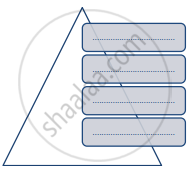Advertisements
Advertisements
प्रश्न
Write differences.
Education in the Ancient Period and Colonial period in Indian society
उत्तर
| Education in the Ancient Period in Indian society | Education in the Colonial Period in Indian society |
| 1. In ancient times, education was provided on the basis of the caste system under the guidance of a guru. | Schools and colleges were open to all individuals, irrespective of caste, creed, gender, etc. |
| 2. During the ancient period the content of education was based on sacred literature which was written in Sanskrit - which was not the language of the masses. The language of teaching was also Sanskrit. | The medium of instruction in high school during the colonial period became English which was the common language of communication among the learned people. |
| 3. The content of education was religion-oriented. (The Kshatriyas learnt the art of warfare and administration. Vaishyas studied trade and commerce and Shudras learnt agriculture and animal husbandry. The Brahmanas attained mastery of the four Vedas) During the later Vedic period there was an emphasis on the institution of sacrifice. | The content of education was not religion-oriented It was secular - which included subjects like Mathematics, Science, Philosophy, Sociology, History etc. |
| 4. The aim of education was to sharpen the intellect as well as for character formation. The value was attached to being truthful, carrying out one's duties (dharma), devotion to the guru, and to one's parents, hospitality, faith, and generosity. | New values like rationality, equality, social justice, secular approach and individualism gained firmer ground in the colonial period. |
APPEARS IN
संबंधित प्रश्न
What was the nature of education during the Early Vedic period?
Maktabs were centres of ______.
Correct the incorrect pair and rewrite it.
| I | Brahmin – Priest |
| II | Kshatriya – Trader |
| III | Vaishya – Farmer |
| IV | Shudra – Menial work |
Correct the underlined word and complete the statement.
Shia and Sunni are sects in Judaism.
Status of women in India during Later Vedic Period.
Explain the following concept with example.
Madrasa
Complete the concept map.
Caste hierarchy

State whether the following statement are true or false with reason.
Religious teachings have no influence on human behaviour.
Correct the underlined words and complete the sentence.
Sikhism was founded by Guru Govind Singh.
Identify the appropriate term from the given options and rewrite it against the given statement:
It highlights exemplary religious, qualities which are emulated as role models by Jain women.
